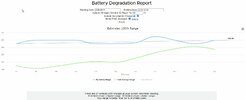LFP batteries have been around now for about 9 months and I was wondering how they are holding up in terms of degradation.
So do you have a SR+ with LFP batteries? Do you use TeslaFi? If so, can you post a PDF of the battery degradation chart?
As an example, I have posted a PDF of mine. However it uses NCA batteries. According to the chart it has lost 9% in 12 months. It will be interesting to compare this with LFP to see if there is a major difference...
So do you have a SR+ with LFP batteries? Do you use TeslaFi? If so, can you post a PDF of the battery degradation chart?
As an example, I have posted a PDF of mine. However it uses NCA batteries. According to the chart it has lost 9% in 12 months. It will be interesting to compare this with LFP to see if there is a major difference...



